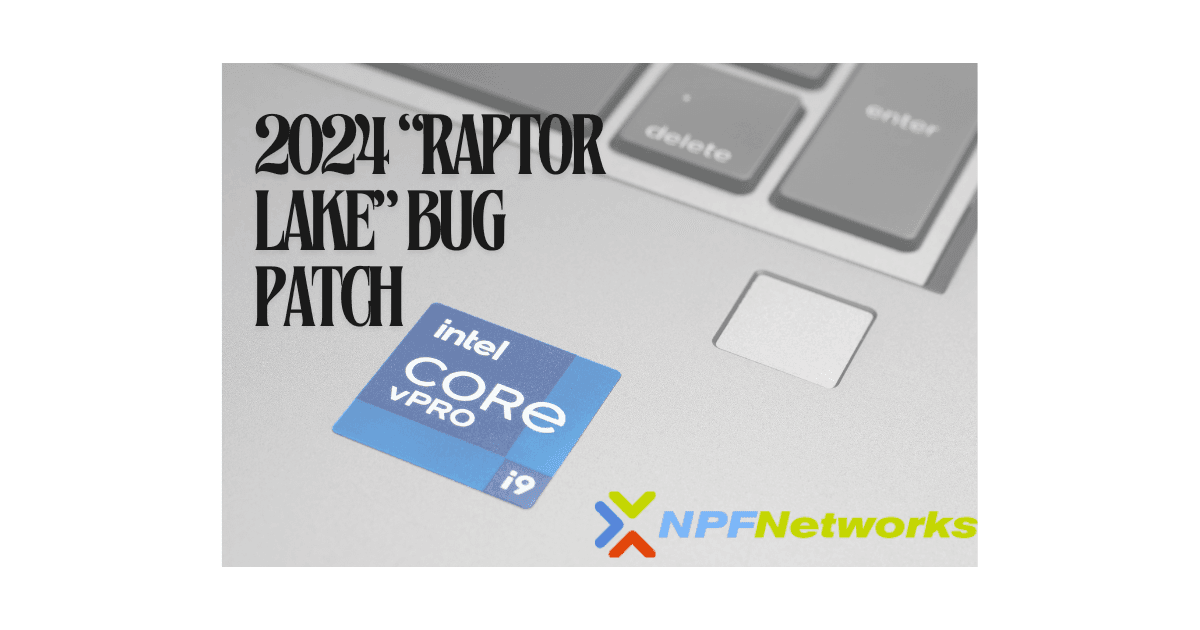Intel’s latest “Raptor Lake” processors have made waves in the tech world, boasting impressive performance gains and advanced features. However, a recent bug patch for these processors has raised concerns about potential impacts on IT performance. If your business relies on Intel’s 13th-generation CPUs, understanding the implications of this bug patch is crucial for maintaining optimal IT operations and NPF Networks is here to help. Call today 303-778-9499
What is the Intel ‘Raptor Lake’ Bug?
The “Raptor Lake” processors, part of Intel’s 13th-generation lineup, have been praised for their enhanced performance and efficiency. However, as with any new technology, bugs are inevitable. Intel recently released a patch to address a critical bug found in these processors. While the patch is essential for system stability and security, it has sparked discussions about its impact on performance.
How Could the Patch Affect Your IT Performance?
The bug patch primarily targets issues related to the processor’s efficiency cores (E-cores), which are designed to handle background tasks and optimize power consumption. However, reports suggest that the patch may cause a reduction in performance, particularly in multi-threaded workloads. This could be concerning for businesses that rely on these processors for high-performance computing tasks, such as data analysis, AI processing, and large-scale simulations.
Signs Your IT Performance May Be Affected
If your business uses Intel’s “Raptor Lake” CPUs, you might notice:
- Slower Multi-Threaded Processing: Tasks that require extensive multi-threading, like complex computations or simultaneous data processing, may take longer to complete.
- Increased Power Consumption: The patch may lead to higher power usage as the processor attempts to compensate for the E-core inefficiencies.
- System Instability: Although rare, some systems may experience instability as a result of the patch, leading to unexpected crashes or reboots.
Mitigating the Impact on Your IT Infrastructure
If you suspect that the “Raptor Lake” bug patch is affecting your IT performance, there are steps you can take to mitigate the impact:
- Monitor System Performance: Use performance monitoring tools to track any changes in CPU usage, power consumption, and processing times. This can help identify if the patch is causing significant slowdowns.
- Optimize Workloads: Consider reassigning tasks to different cores or processors within your network to balance the workload more effectively.
- Update Firmware and Drivers: Ensure that your systems are running the latest firmware and drivers. Intel may release further updates to address performance issues related to the patch.
- Consult with IT Experts: If performance issues persist, consulting with IT professionals, like the team at NPF Networks, can provide tailored solutions to optimize your infrastructure.
Staying Ahead with NPF Networks
At NPF Networks, we understand the critical role that IT performance plays in your business operations. Our team of experts is equipped to help you navigate the challenges posed by hardware updates and bug patches, ensuring that your systems run smoothly and efficiently. Whether you’re dealing with Intel’s “Raptor Lake” bug patch or other IT concerns, we’re here to provide the support and solutions you need.
Intel’s “Raptor Lake” processors represent a significant leap forward in computing power, but the recent bug patch serves as a reminder that even the latest technology can come with challenges. By staying informed and proactive, you can minimize any negative impact on your IT performance and continue to leverage the full potential of your hardware. If you’re experiencing issues or simply want to optimize your IT infrastructure, NPF Networks is here to help. Contact us today at 303-778-9499 to learn more about our services and how we can assist you in maintaining peak IT performance.







Leave a Reply